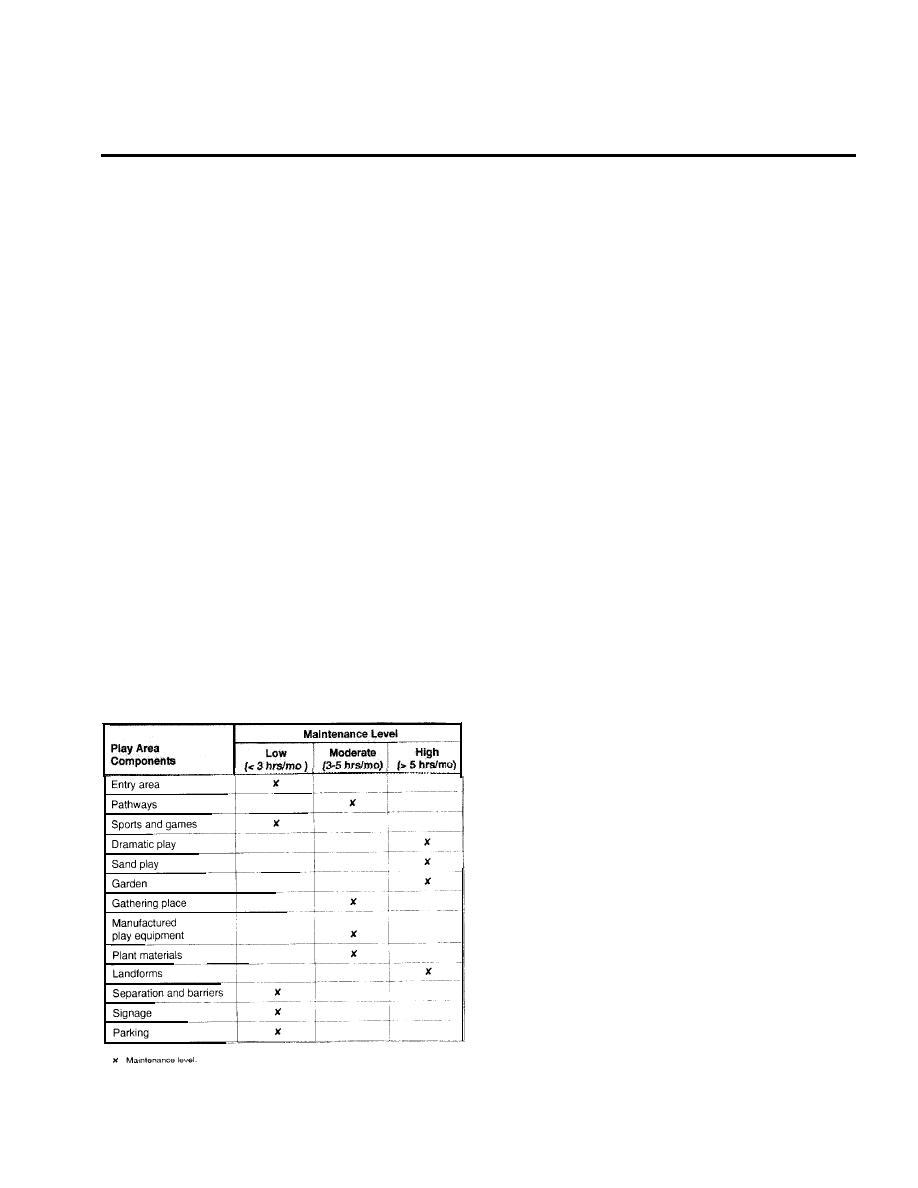
TM 5-803-11/AFJMAN 32-10139
CHAPTER 9
PLAY AREA COMPONENTS
ering places and locations for displaying community
9-1. Introduction.
information. Play components may also have a de-
A play area is more than a collection of play equip-
fined entry. For example, the entrance to the dra-
ment. Many different component parts work to-
matic play component can be marked by an arch,
gether to support child development and play in a
flag, or banner. Entries may also include play activi-
quality play environment. Some components create
ties, such as games or interactive exhibits.
defined settings that support play activities, such as
a. Design Elements. An entry may include: arches
sand play, dramatic play, and pathways. Other play
area components, such as gathering places and
and gateways, pathways, sculpture and other art
work, community bulletin boards, informational
signage, provide comfort and convenience for users.
This chapter provides design guidelines for play
signs, interpretive signs, graphic signage, interac-
tive play events, surfacing, seating, tables, bike
area components. For each component, design con-
racks, drinking fountains, restrooms, shelters, veg-
siderations, age appropriateness, safety consider-
etation, and trash receptacles. Temporary or perma-
ations, and required level of maintenance is identi-
fied.
nent embellishments may include banners, flags,
decorations, and posters.
9-2. Maintenance Requirements.
b. Recommended Ages. All ages will use the entry.
Maintenance requirements are an important fac-
c. Safety Concerns.
tor to consider when selecting play area compo-
(1) Visibility. Visibility from the surrounding
nents. Rough estimates of required maintenance for
neighborhood should not be obstructed. Design ele-
the play area components are summarized in table
ments such as vegetation should not block views
91. Actual maintenance needs cannot be deter-
into the play area from adjacent streets or housing.
mined until the design elements for each component
(2) Separation From Traffic. Entries should be
are selected.
separated from parking and traffic with barriers,
9-3. Entry Area.
such as bollards.
Play area entrances should create a welcoming
(3) Signage. Entries are a good location for in-
feeling. Defined entrances may serve as social gath-
formational signage describing play area layout and
the age groups served. However, it should not be
Table 91. Maintenance Requirements for Play Area
assumed that children will read and understand
Components.
written warning signs.
d. Maintenance Level. The level of maintenance
required for this play area component is low. A well-
maintained entrance creates a positive first impres-
sion of' the play area.
9-4. Pathways.
Two types of pathways may be provided. Primary
pathways provide accessible routes of travel to the
play area, around the play area, and to all acces-
sible activities within a play area. Auxiliary path-
ways are secondary pathways.
a. Design Elements. Pathways may include: sur-
faces, curb cuts, ramps, crosswalk markings, curbs,
vegetation, seating, signage, and lighting.
( 1 ) Pathways Layout. Pathways should be in-
stalled along likely routes of pedestrian travel.
(2) Primary Pathways Leading To and Around
the Play Area. When a road crossing cannot be
avoided in order to reach the play area, curb cuts,
ramps, and crosswalk markings should be provided.
9-1



 Previous Page
Previous Page
